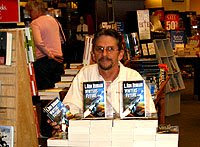Noir writers wrote with a detachment most of the world felt during the years after World War 2 when a sullen hush washed across battered nations numbed by the task of recovery. Many of those writers were themselves combat veterans, and, I suspect, used writing as a means of recuperation from what we now understand as PTSD. It was as if they pictured their story plots, like men standing in the shadows of alleys while out on Main Street life progressed through the struggles writers used to convey their protagonist’s adventures but did not necessarily partake in.
Although, I believe noir fiction began under the ink stained fingers of John Carroll Daley while he wrote for the Dime Detective Magazine in the 1930s. His protagonist Race Williams was as brutal as life in the Great Depression, used violence to uphold the law as he, Race Williams, interpreted it. Readers enthralled by Daley’s writing, let the story’s darkness shed the light of hope into lives lived hand to mouth, which helped create the genre.
Mickey Spillane, who I was fortunate to spend time with during the last years of his life, as a young boy read Daley’s stories and later used what he’d learned when he walked Mike Hammer off the pages of comic books and into one of the most successful mysteries ever written, I, The Jury.
While I was a young boy, I read Mickey’s books. The pacing, tension and almost machine gun style of writing turned the pages for me. I believe that noir fiction is similar to modern Jazz as introduced in the 1950s and 1960s. It is a free form style of writing, which at times drags the reader along, coddles the senses with imagery, and at other times jerks him up in his chair as if daring him to relax and read. The characters are in your face people, with each other, and a film of tension dangles between them like spider web filament.
When I created Marlowe Black and his illegitimate son Michael Hacker McKaybees, I wanted the tension between them to navigate plots. Marlowe Black whose pregnant fiancee was murdered in the early 1950s (the plot for Sunset Orange Water) refused to ever again consider marriage. He avoided intimate relationships, staying around until emotions grew thick, and he began glancing over his shoulder should his new love face the retribution his first one had due to the nature of his profession.
When the woman who would become Hacker’s mother, announced her pregnancy in 1971, Marlowe immediately decided that he would not be seen with his new son therefore giving the boy the opportunity to live. Marlowe knew he had dragged some of his enemies through the previous decades and felt their hypothetical breaths on the back of his neck.
Now, in the twenty-first century, Marlowe, although a man nearing eighty, continues to work as a PI. He had kept an eye on his son, and provided for him and his mother. He felt pride as the boy grew into a man, but stayed away.
Until the day when an old army buddy’s son, a New York City cop, was brutally murdered and he and Hacker were considered prime suspects. Then all the rules changed, and Marlowe Black knew it was time to educate his son about dealing with criminals the old way, using fists and guns. Shoot first and ask questions should one of the enemy, be lucky, or unlucky enough to remain standing.
A thousand little rock-hammers
-
Readers, I’ve got a wishlist.
All year I encounter anti-Christianity stuff, often posted as funny and
there’s always a holiday uptick. I’m pretty sur...
2 months ago






















